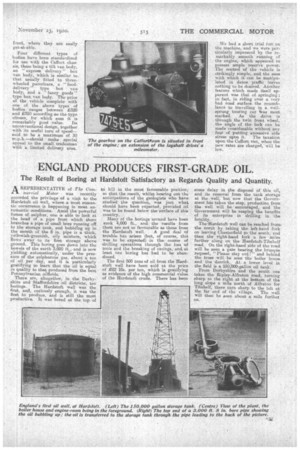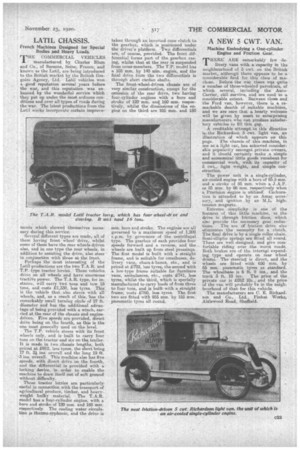ENGLAND PRODUCES FIRST-GRADE OIL.
Page 19

Page 21

If you've noticed an error in this article please click here to report it so we can fix it.
The Result of Boring at Hardstoft Satisfactory as Regards Quality and Quantity.
A, REPRESENTATIVE of The Corn inercial Motor was recently accorded the privilege of a visit to the Hardstoft oilwell, where a most romantic occurrence is happening in most unromantic conditions. Amid the powerful fumes of sulphur, one is able to look at the head of a pipe from which there branches a pipe of small bore running off to the storage tank, and bubbling up in the mouth of the 8 in. pipe is a thick,•
v oily mixture, which flows away to its first storage above ground. This boring goes clown into the bowels of the earth 3,000 ft., and is now yielding automatically, under the pressure of the sulphurous gas, about a ton of oil per day, and it is particularly gratifying to lean, that the oil is equal in quality to that produced from the best Pennsylvanian oilfields. There are, altogether, in the Derbyshire and Staffordshire oil districts, ten borings. The Hardstoft well• was the 4rst, and, curiously enough, it was the first to produce, and is still the most productive. It was bored at the top of ta hill in the most favourable position; so that the result, whilst bearing out the anticipations of the geologists who have studied the question, was just what, should have been expected, provided oil was to be found below the surface of this country. Many of the borings around have been sunk 4,000 ft., and the results from them are not so favourable as those from the Hardstoft well. A good deal of trouble has arisen (but, of course, thii was to be expeeted) in the course of drilling operations through the loss of tools and the breaking of casings, and, at least one boring has had to be abandoned.
The first 500 tons of oil from the Hardstoft well have been sold at the price of £22 10s, per ton, which is gratifying as evidence of the high commercial value of the Hardstoft crude. There has been
some delay in the disposal of this oil, and its removal from the tank storage at the well, "but now that the Government has taken the step, production from the well will be encouraged, and the Government will be reaping the benefits of its enterprise in drilling in the locality.
The Hardstoft well can be reached from. the north by taking the left-hand fork on leaving Chesterfield to the south, and then the right-hand fork a few miles further along on the Hardstoft-Tibshelf road. On the right-hand side of the road will be seen a gate bearing the brusque request, "Please stay out! ' and behind the trees will be seen the boiler house and the derrick. Ata lower level in the field is a 150,000-gallon oil tank.
From Derbyshire and the south one takes the Ripley-Alfreton road, turning sharp to the right at the bottom of the long slope a mile north of Alfreton for Tibshelf, there turn sharp to the left at the far end of the village. The well will then be seen about a mile further on.
LATIL CHASSIS.
French Machines Designed for Special Bodies And Heavy Leads, THE COMMERCIAL VEHICLES manufactured by Charles Blum and Co., of Suresne, Seine, France, and known as the Latil, are being introduced to the British market by the British Gregoire Agency, Ltd, Latil vehicles won a -good reputation several years before the war, and this reputation was enhanced by the wonderful service which they put up under the most arduous conditions and over alltypee of roads during the war. The latest productions from the Latil works incorporate certain jmprove-•
merits which showed themselves neceseery during this service; Several different types are made, all of them having front wheel drive,, whilst same of them have the rear wheels-driven also, and in one type the rear wheds, in addition to assisting the drive, also steer in conjunction with theee at the front.
Perhaps the most interesting of the Latil productions are the twn T.A.R. and T.P. type tractor lorries. These vehicles drive, on all ix-heels and have enormous tractive power. The T.A.R. type, for instance, will carry two tons and tow 18 tone, and costs £1,330, lees tyres. This is the vehicle that also steers with all wheels, and, as a result of this, has the remarkably small turning circle of 27 ft. diemeter and has the additional ad-vantage of being provided with a winch, carried at the rear of the ehasSis and enginedriven. Five speeds are provided, direct drive being on the fourth, as this is the one Most generally used on the level.
The T.P. vehicle steers with its front wheels only, and is built to carry four tons on the. tractor and six on the trailer: It is made in two _chassis lengths, both priced at. £912, lees tyees, the shout being 17 ft. 2i ins. overall and the long 19 ft. 3 ins. overall. This machine also has five speeds, with direct drive on the fourth, and the differential is provided with a locking device, in order to enable the machine to draw itself out of soft ground without difficulty.
These tractor terries are particularly -Adel in connection with the transport of agricultural produce. timber, and heavyweight bulky material. The T.A.R. mode! has a four-cylinder engine, with a here and stroke of 120 mm. and 160 mm. respectively. The cooling water circulation is therp3o-sephonie, and the drive is
taken through an inverted cone clutch to the gearbox, which is positioned under the driver's platform. Two differentials are, of course, provided. The front differential forms part of the gearbox easing, whilst that at the rear ie suspended from ceoss-members. The T$. model has a 105 mm. by 140 mm. engine, and the final drive from the two differentials is through sheet cartian shafts.
The front-wheel-driven chassis are of very similar construction, except for the omission of the rear drive, two' having four-cylinder engines with a bore and stroke of 120 ram. and 160 mm, respectively, whilst the dimensions cif the engine on the third are 105 mm. and 150 min. bore and stroke. The engines are all governed to a maximum speedof 1200, r.p.m. by governors of the centrifugal type. The gearbox of each provides four speeds forward and a reveres, and the wheels are built up from steel pressings. The first model is built with a straight frame, and is suitable for omnibuses, delivery vane, chars-ehance, etc., and is priced at £722, less tyres, the second with a low-type frame Suitable for furniture vane, ambulanees, etc., costs £741, less tyres, whilst the third, which is specially manufactured to carry loads of frern three to four tons, and is built -with e straight frame, costs £760, less tyres. The, first two are fitted with 955 mm. by 155 mm. pneumatic tyres all round.
A NEW 5 CWT. VAN.
Machine Embodying a One-cylinder Engine and' Friction Gear.
"THERE'ARE nernarkahly few de livery vans with a, capacity in the neighbourhood of 5 cwt. on the British market, although there apneare.to be a considerable fieid for this class of machine. Before the war there Was quite a number of threenvheis,led parcelcars, of which several, including the AutoCarrier, still survive, and are used to a considerable extent. Beeween these and the Ford van, howeeer, there is a remarkable dearth of suitablemachines, and we are sure that a hearty welcome will be given by users to enterprising manufacturers who can produce satisfactory eehiclee to fill this gap. • A creditable attempt in this direction is -the Richardson 5 cwt. light van, an illustration oif which appears on this
page. The chassis of tins elm-chine, in. use as a light car, has achieved considerable popularity amongst private owners, and it should certainly make a simple and economical little goods runabout for commercial work, with its capacity of 5 cwt., light weight, and simple construction.
The power unit is a single-cylinder, air-cooled engine -with a bore of 85,5 mm, and a stroke of 85 min, when a IA,P. or 85 mm. by 06 rem, respectively when Peecision engine is utilized'. Carburation is attended to by an Amac accessory, and ignition by an ALL: hightension .magneto.
Extreme simplicity is one of the features -of this little machine, as the 'drive is through friction discs, which also providethe necessary gear reduc tions. The use. erf friction drive also eliminates the 'necessity for a • clutch. The final drive is by a single roller chain. Semi-elliptic springs are fitted all round. These are well designed, and give comfortable riding over the worst roads. Both brakes are of the internal expanding type and operate on rear wheel drums. The steering is direct, and the wheels are fitted with 650 mm. by 65 mm. pneumatic tyres as standard. The wheelbase is 6 ft. g ins., and the track' 3 ft. 10 iris. The price of the private ear is £262 10s., and the price of the van will probably he in the neighbourhood a that for this vehicle.
The manufacturers are C. E. Richardeon and Co. LW., Fin-bat Works, Aiziewood Roa:ci, Sheffield.




























